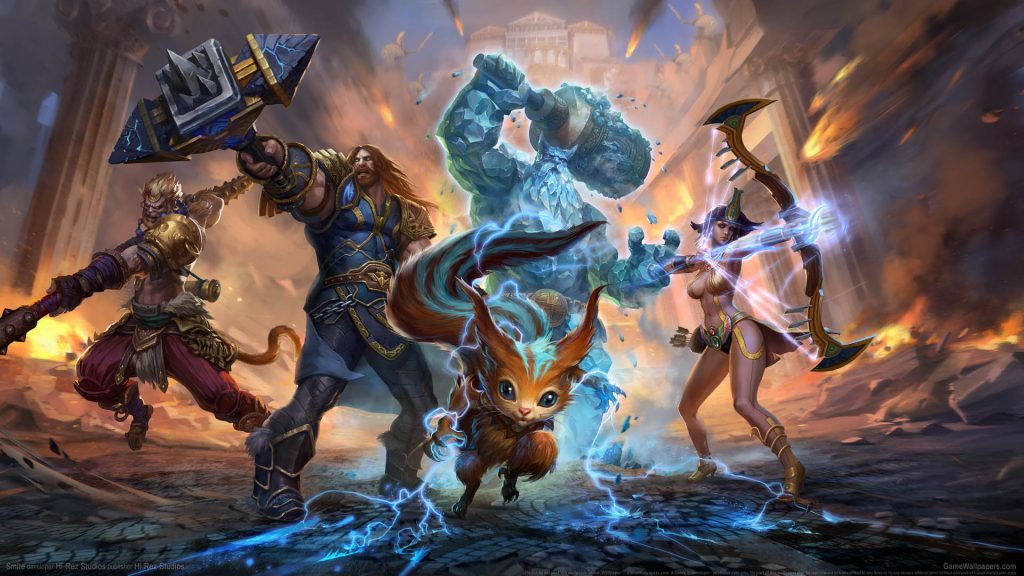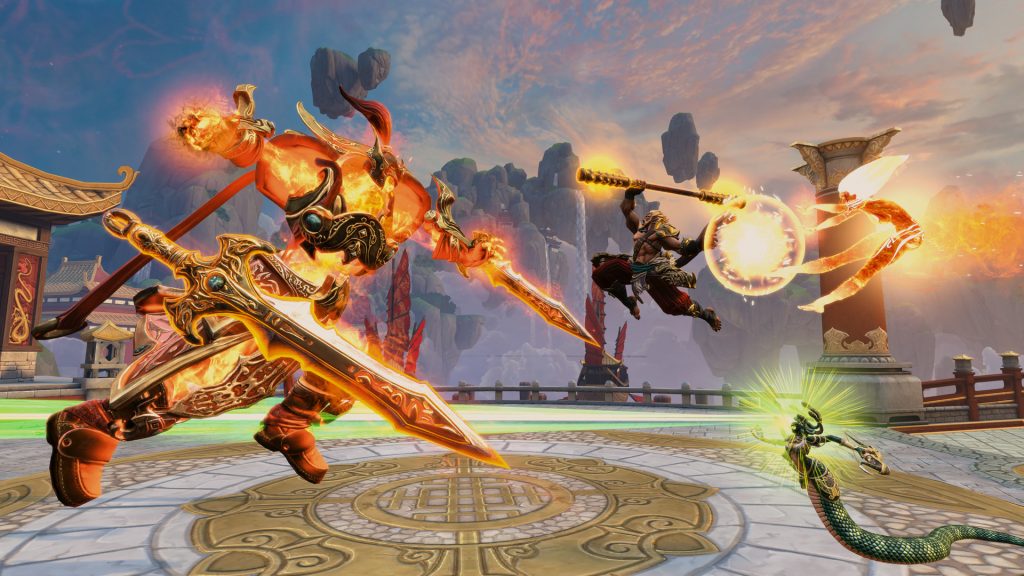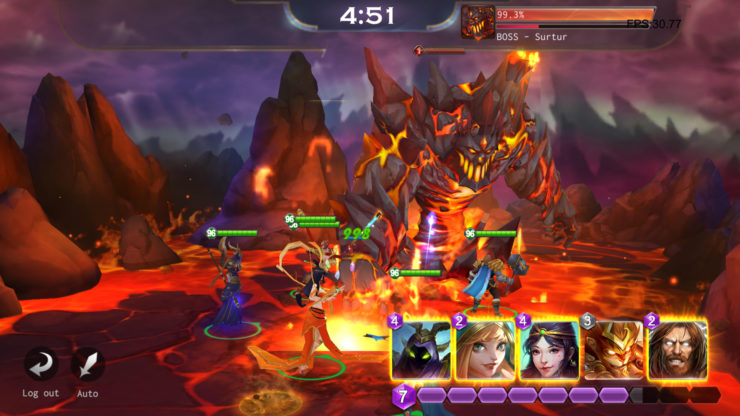Today
Today’s earlier broadcasts
Upcoming
Odds
Results
News
Guide
History
Smite (SMITE) is a third person multiplayer online battle arena video game, released by Hi-Rez Studios in 2014. Subtitled “Battleground of the Gods” the game puts the player in the role of a deity or similar mythological character to battle the opponent.
There are several game modes but most popular is the Conquest mode in which 2 teams of 5 a side each seek to destroy the Titan at the centre of the opponents base, whilst at the same time preventing their own Titan (base) from being destroyed. Although Smite was not the first multiplayer online battle arena game in the world, it was the first to focus exclusively on characters inspired by deities and mythological figures from real-world pantheons. There are around 100 characters for players to choose from, and those characters are taken from thirteen different pantheons, including Roman, Chinese, Mayan, Norse, Hindu and Egyptian.
Gameplay
When a game begins in Conquest mode, each team of five players is situated at opposite ends of the map. The players each receive a sum of gold which they can use to equip themselves with weapons and powers to defeat the opposing team. Three lanes run across the whole map, and each lane is protected by a Phoenix and two towers. The teams must destroy the Phoenix and towers of the opposing team before finally destroying the Titan. Players are assisted in their quest by minions, who help to attack opposing players and anything else in their path.
Tournament History
Smite has been an esports event for several years, with Hi-Rez Studios itself making it possible for teams of players to compete professionally. The first Smite World Championship was held in Atlanta, Georgia, in January 2015 and offered a total prize pool of $2.6 million, half of which was taken by the winner. The Smite World Championship has been held every January since that 2015 beginning, and although the total amount of prize money on offer has decreased over time (to $1 million in 2016 and 2017, and $785,000 in 2018) the interest amongst those who watch Smite matches has remained strong.
There aren’t many games that allow you to watch what happens when deities go head-to-head in battle, so Smite matches are rather unique in the esports scene and should continue to attract audience. Stay tuned with esportsguide to keep yourself updated with all live and upcoming matches.
Guide
A Brief Background
Smite is a multiplayer online battle arena game (more commonly referred to as “MOBA”), published and developed by Hi-Rez Studios. As opposed to other popular MOBA games on the esport scene, Smite is played from a third-person perspective. The game is built on a mythological concept where the players take control of different gods from a various list of mythological stories from all over the world.

The game is free-to-play and built on a microtransaction model that allows players to purchase cosmetic items and new characters. The cosmetic items does not affect the gameplay in any way, and you don’t need to spend money to unlock new characters as these also can be purchased with the in-game currency that’s rewarded for playing.
The game was released in March 25, 2014 and has since got a lot of updates. It’s become a popular game and has made a pretty big impact within the esport scene with multiple big events and tournaments with large prize-pools being held annually.
In Smite, players take part in team combat consisting of five players in each team. Every player individually picks a god from an impressive roster of 103 unique characters, each with different abilities, strengths and weaknesses. The end goal of the game is to destroy the enemy teams Titan, which is a giant warrior positioned in each team’s base.
As the game progresses, players will level up their gods by either killing enemy gods, enemy minions or defeating defending towers and advancing closer to the enemy base. Players will also gather gold by performing these feats, and this currency is very important, since it’s used to purchase different items that increase various stats such as health, damage and defense for your god.
How to Play
The main goal of Smite is to push forward your enemy’s base to reach their Titan and slay it. To do so, each team first has to progress through 3 different lanes on the map, and spread out on these lanes each team has equal amounts of defense towers and “Phoenix” birds that deals a lot of damage to any enemy a god is getting to close. Each lane is also supported by non-player-controlled minions that helps to push the lanes.

Before every game each player has to select a god to play throughout the entire game, and since all the gods have a very different set of skills and abilities, it’s important to find a couple of gods that suit your playstyle as you can’t switch your god when the game would have started. Two players in the same team can’t pick the same god, hence it’s important for you to familiarize yourself with at least a couple of them.
Every god is placed in one of the following classes: Warrior, Mage, Guardian, Assassin or Hunter. All classes can acquire four different abilities, with a fifth being a passive. The abilities range from damage dealing spells and attacks, to buffs that enhance either your own or your teammates’ gods to crowd control abilities that limit enemy players movement or ability to cast spells. All the gods start off very weak, with few abilities.
This is where you decide with your team on which lane you will focus on, and by progressing down the lane by killing minions and attacking defense towers and phoenix birds, you will accumulate gold and experience which can be used to enhance your god with new spells and items.
To gather gold at a quicker pace, it’s very important that you get to strike the killing blow on the minions as this will reward you with extra gold. As opposed to other MOBAs, you can’t deny minions for your enemies, so keeping up with the last-hits should be easier for you in this game.
Whilst pushing the lanes and defense towers, you also have to keep an eye out for the enemy gods. Since they have the same objective as you, to push your lane – this is where the player-versus-player action starts. It’s vital that you make sure you’re controlling the lane and not letting the enemies kill your god, as player kills are highly rewarded and will make them level up and grow stronger and at a faster pace than you. If this happens they can easily continue to attack you, take advantage of their higher level and easily continue to kill you and start eliminating your defense towers to slowly progress towards your base.
In a situation like this, it’s very important that you communicate with your team and ask for help, to hopefully set up a successful “gank” of the enemies that are harassing you. When ganking an enemy, you have your teammates leave their lanes for a short while to try and flank the enemies on your lane in order to stop their killing spree.
If successful, it will give you a chance to even out the odds and maybe progress a bit further down their lane to hopefully even eliminate a phoenix. However, if the gank isn’t successful, your whole team will be put in a very bad spot as the enemies now have several of your lanes totally unprotected. This can allow them to progress further on a number of lanes which will put a lot of pressure on your team. Risk versus reward!

Later on in the end-game, it’s very common for all gods to have reached high levels and equipped with powerful items. This is when the teams will try to push towards the enemy Titan. This stage of the game requires good communication and synchronised attacks, as losing gods and having less number of players out on the field can be the way to a loss.
The team that has managed to grind most gold and experience is often the successful one in the end game, as it can easily win in player encounters thanks to their stronger gods. When one of the teams successfully have entered the enemy base and eliminated their Titan, they will be victorious.
How to Watch
A while after its release, Hi-Rez Studios released a system in the game which allowed players to join a set of professional leagues in teams of 5. In these leagues, teams were ranked for their performance and could later into the seasons perform well enough to get invited to the Smite World Championship that were hosted the first time in January 9, 2015. Since then Smite have managed to stay relevant in the esport scene with big tournaments and huge prize-pools.
If you want to stay updated on Smite and its esports you can visit the official Hi-Rez website. There, you can find live streams to watch, old VOD’s of earlier games, leaderboards, results and much more. You can also visit their official mixer channel where they often broadcast tournaments and events.
- https://esports.smitegame.com – Smite official esport website.
- https://mixer.com/smitegame – Smite official Mixer channel.